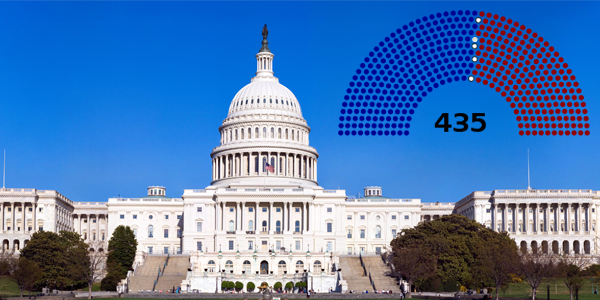
How the 2020 Census Will Change the U.S. House
Written by Matt Palumbo
The conclusions of a recent Center for Immigration Studies (CIS) paper were misinterpreted and misreported by some as claiming that Republicans would lose twenty-four seats in states that voted for Donald Trump as a result of the 2020 census. What the study actually said was that because we count legal non-citizens and illegal aliens in the Census for population (which determines how representation is apportioned), the cumulative effects of that are that Democrats have twenty-four more seats than they otherwise would’ve had we never counted non-citizens and illegals in the first place.
That is not to say that twenty-four seats are going to be redistributed in 2020 (and even having reported this in an earlier write-up of the study, I can still see why some were confused).
Of the changes specific to the 2020 Census, the inclusion “Illegal immigrants alone in 2020 will redistribute three seats, with Ohio, Alabama, and Minnesota each having one fewer seat than they otherwise would have had, while California, New York, and Texas will have one additional seat.” Texas is the only red state on the list, but it’s becoming increasingly purple. The inclusion of illegals and non-citizens “redistributes eight seats, with Ohio, Michigan, Missouri, Minnesota, Alabama, Idaho, West Virginia, and Rhode Island each having one fewer seat in 2020 due to the presence of non-citizens in other states. California will have three additional seats; Texas will have two more seats; and Florida, New Jersey, and New York will each have one more seat.”
That clarification aside, the overall seat changes expected to occur as a result from the 2020 census overall are as follows:
| Current Seats | Projected Seats | Change | |
| Alabama | 7 | 6 | -1 |
| Alaska | 1 | 1 | 0 |
| Arizona | 9 | 10 | +1 |
| Arkansas | 4 | 4 | 0 |
| California | 53 | 52 | -1 |
| Colorado | 7 | 8 | +1 |
| Connecticut | 5 | 5 | 0 |
| Delaware | 1 | 1 | 0 |
| Florida | 27 | 29 | +2 |
| Georgia | 14 | 14 | 0 |
| Hawaii | 2 | 2 | 0 |
| Idaho | 2 | 2 | 0 |
| Illinois | 18 | 17 | -1 |
| Indiana | 9 | 9 | 0 |
| Iowa | 4 | 4 | 0 |
| Kansas | 4 | 4 | 0 |
| Kentucky | 6 | 6 | 0 |
| Louisiana | 6 | 6 | 0 |
| Maine | 2 | 2 | 0 |
| Maryland | 8 | 8 | 0 |
| Massachusetts | 9 | 9 | 0 |
| Michigan | 14 | 13 | -1 |
| Minnesota | 8 | 7 | -1 |
| Mississippi | 4 | 4 | 0 |
| Missouri | 8 | 8 | 0 |
| Montana | 1 | 2 | +1 |
| Nebraska | 3 | 3 | 0 |
| Nevada | 4 | 4 | 0 |
| New Hampshire | 2 | 2 | 0 |
| New Jersey | 12 | 12 | 0 |
| New Mexico | 3 | 3 | 0 |
| New York | 27 | 26 | -1 |
| North Carolina | 13 | 14 | +1 |
| North Dakota | 1 | 1 | 0 |
| Ohio | 16 | 15 | -1 |
| Oklahoma | 5 | 5 | 0 |
| Oregon | 5 | 6 | +1 |
| Pennsylvania | 18 | 17 | -1 |
| Rhode Island | 2 | 1 | -1 |
| South Carolina | 7 | 7 | 0 |
| South Dakota | 1 | 1 | 0 |
| Tennessee | 9 | 9 | 0 |
| Texas | 36 | 39 | +3 |
| Utah | 4 | 4 | 0 |
| Vermont | 1 | 1 | 0 |
| Virginia | 11 | 11 | 0 |
| Washington | 10 | 10 | 0 |
| West Virginia | 3 | 2 | -1 |
| Wisconsin | 8 | 8 | 0 |
| Wyoming | 1 | 1 | 0 |
The states picking up seats are Arizona (1), Colorado (1), Florida (2), Montana (1), North Carolina (1), Oregon (1), and Texas (3). Every state gaining seats voted for President Donald Trump in 2016, with the exception of Colorado and Oregon.
The states losing seats are Alabama (-1), California (-1) Illinois (-1), Michigan (-1), Minnesota (-1), New York (-1), Ohio (-1), Pennsylvania (-1), Rhode Island (-1), and West Virginia (-1). This list is more evenly split politically, with California, Illinois, New York, and Rhode Island having voted blue in 2016 (as they always tend to).
States that voted for Trump as gaining eight seats and losing five (for a net +3), while states that voted for Hillary Clinton are gaining two seats while losing four (for a net -2). In other words, states that votes for Trump are expected to see an increase in representation – albeit an insignificantly small one.
Note that this does not contradict the findings of what CIS found at all. The cumulative effects of counting immigrants (both legal and illegal) in population tolls have allowed representation to be disproportionate in blue states. However, when it comes to districts being redrawn specifically in 2020, there is no mass shift in favor of Democrats.
This article was originally published at Bongino.com.












